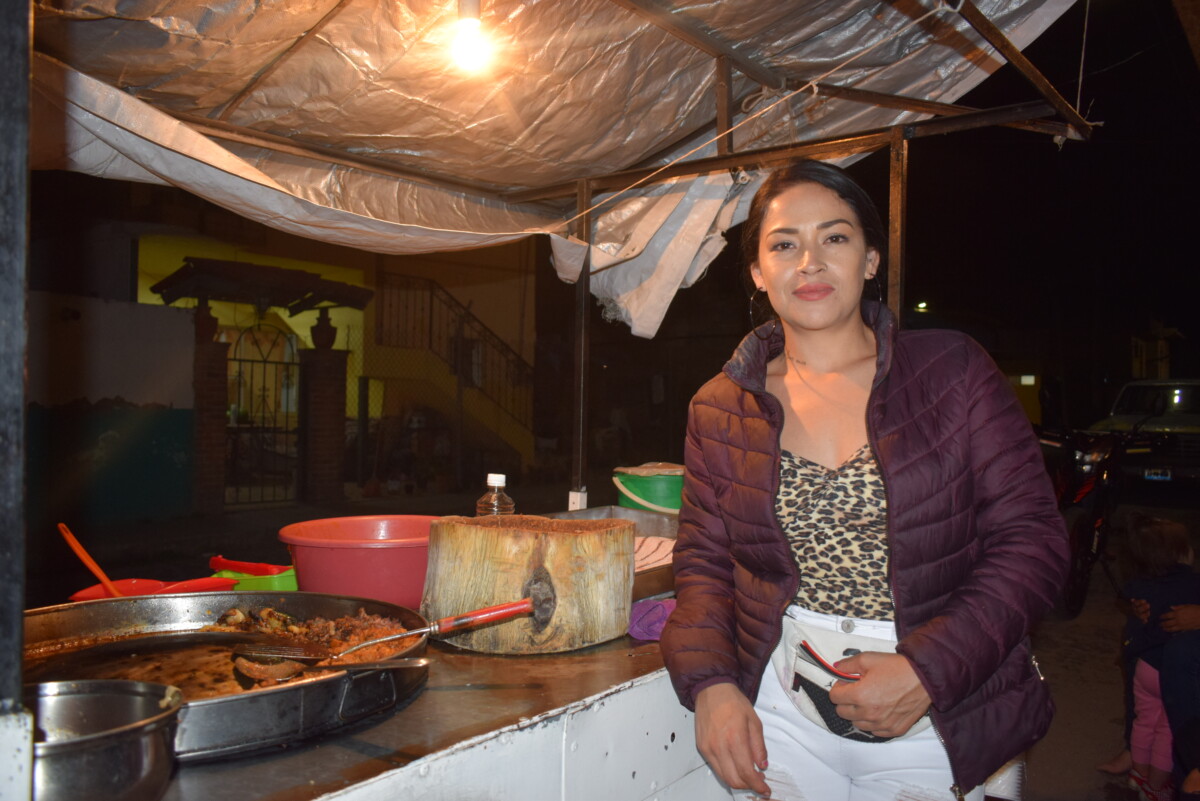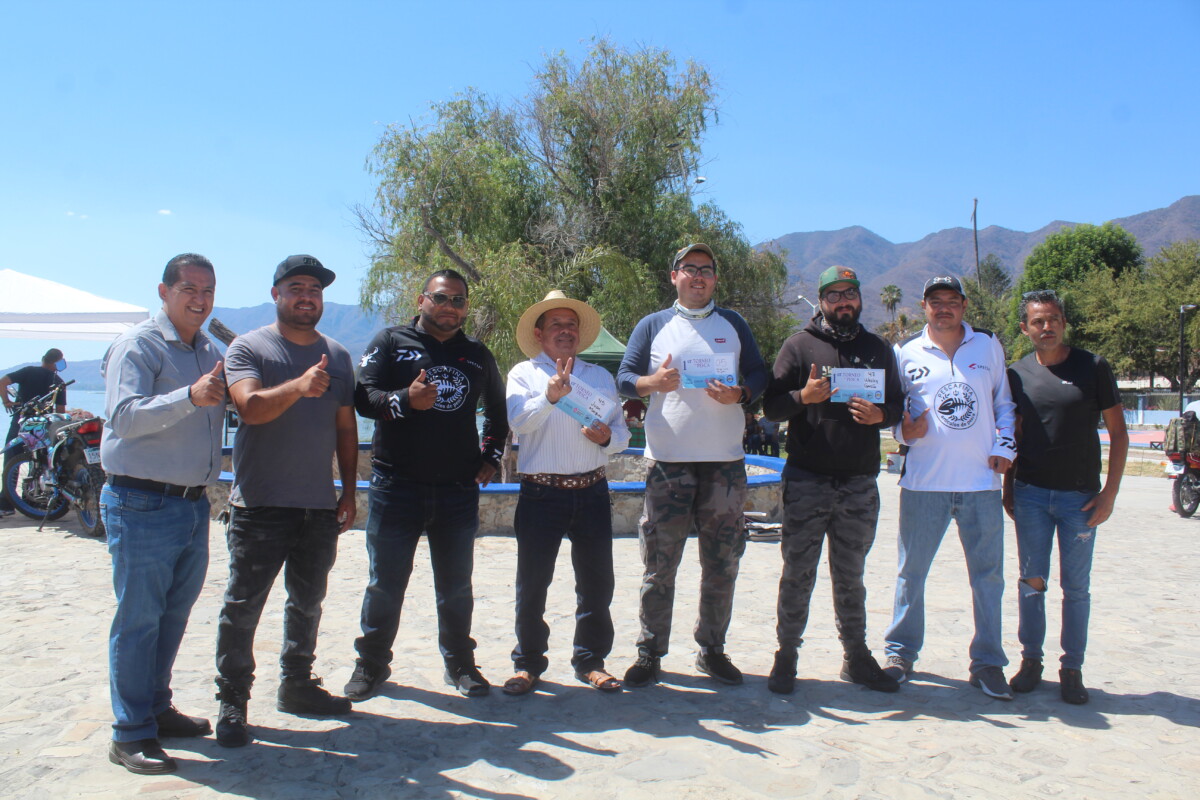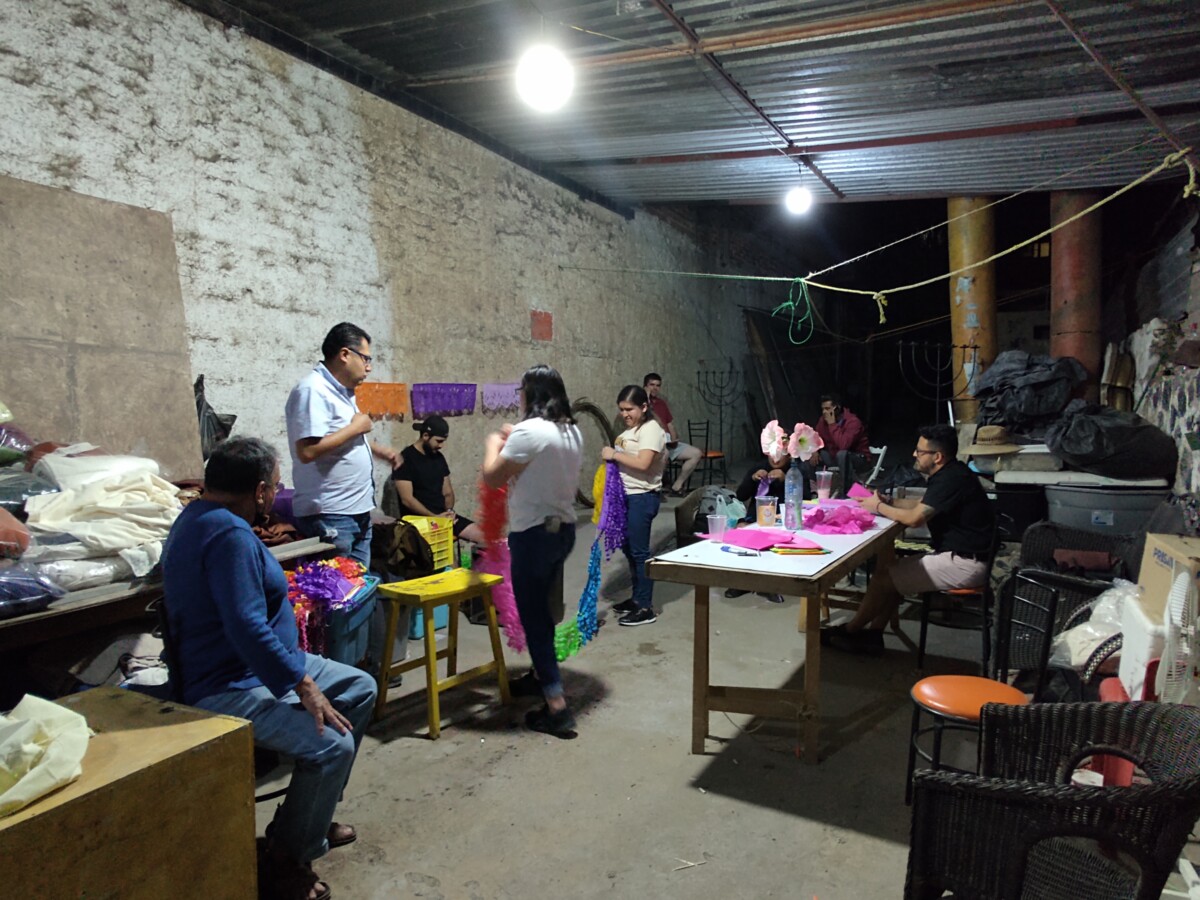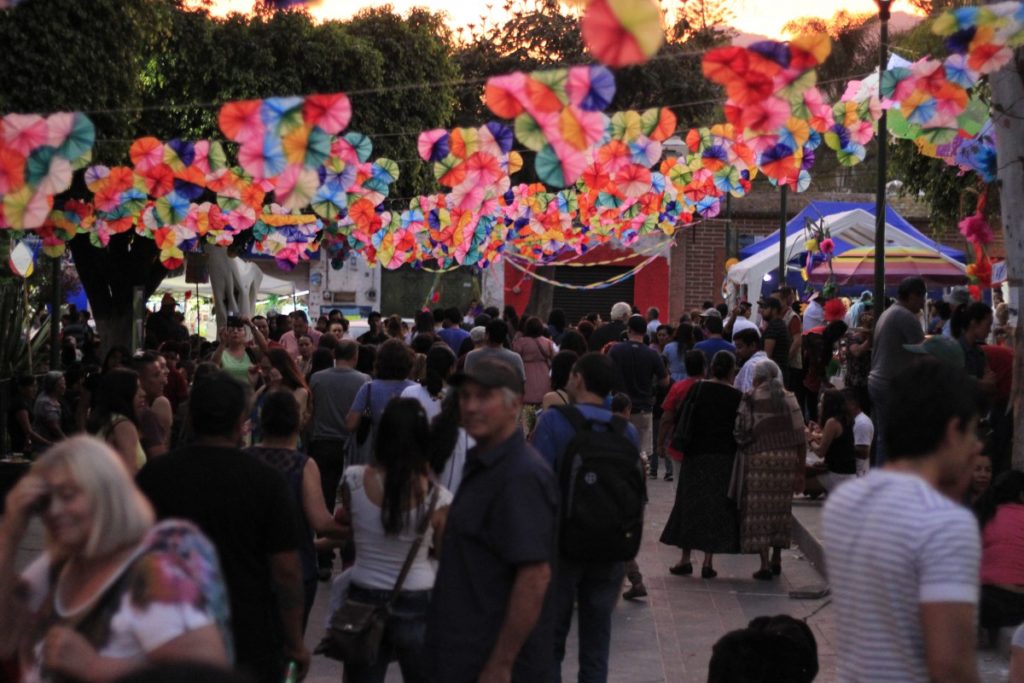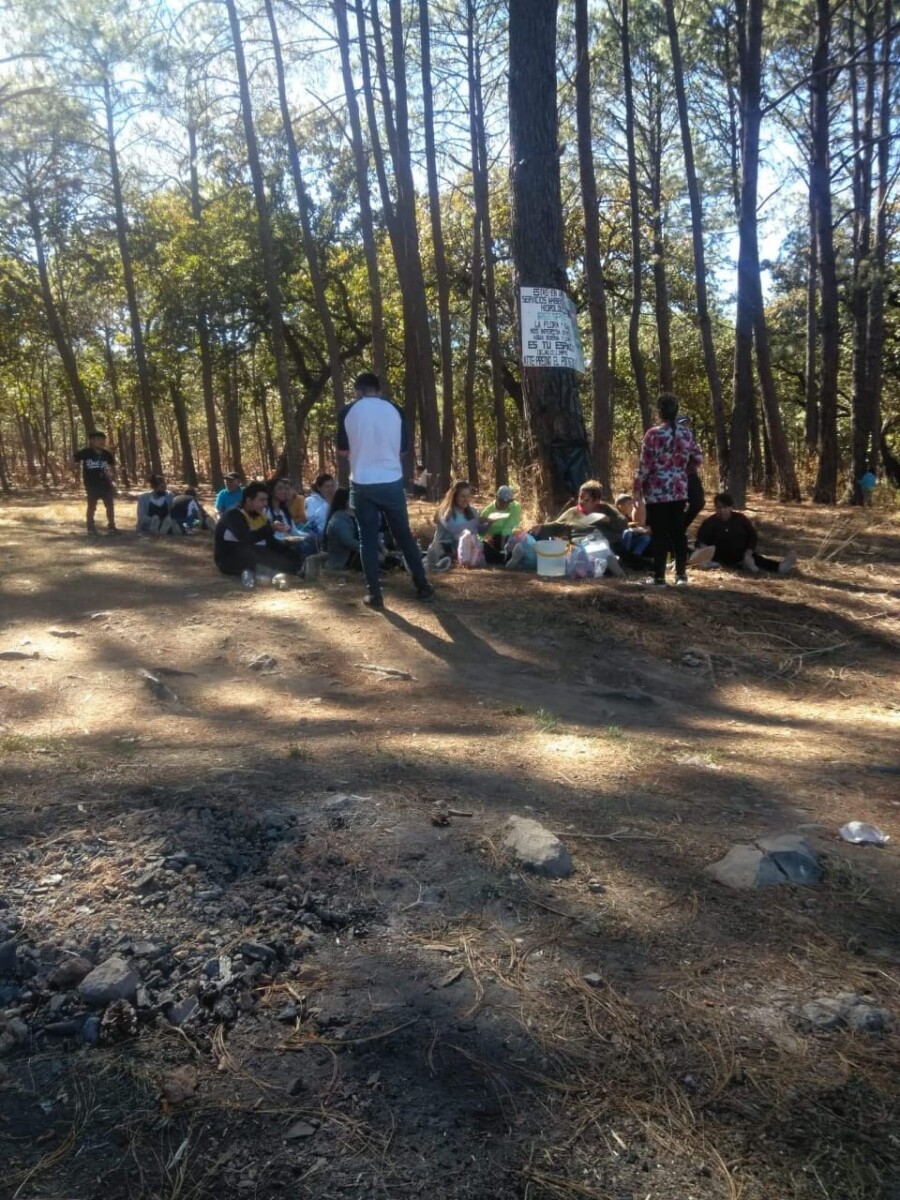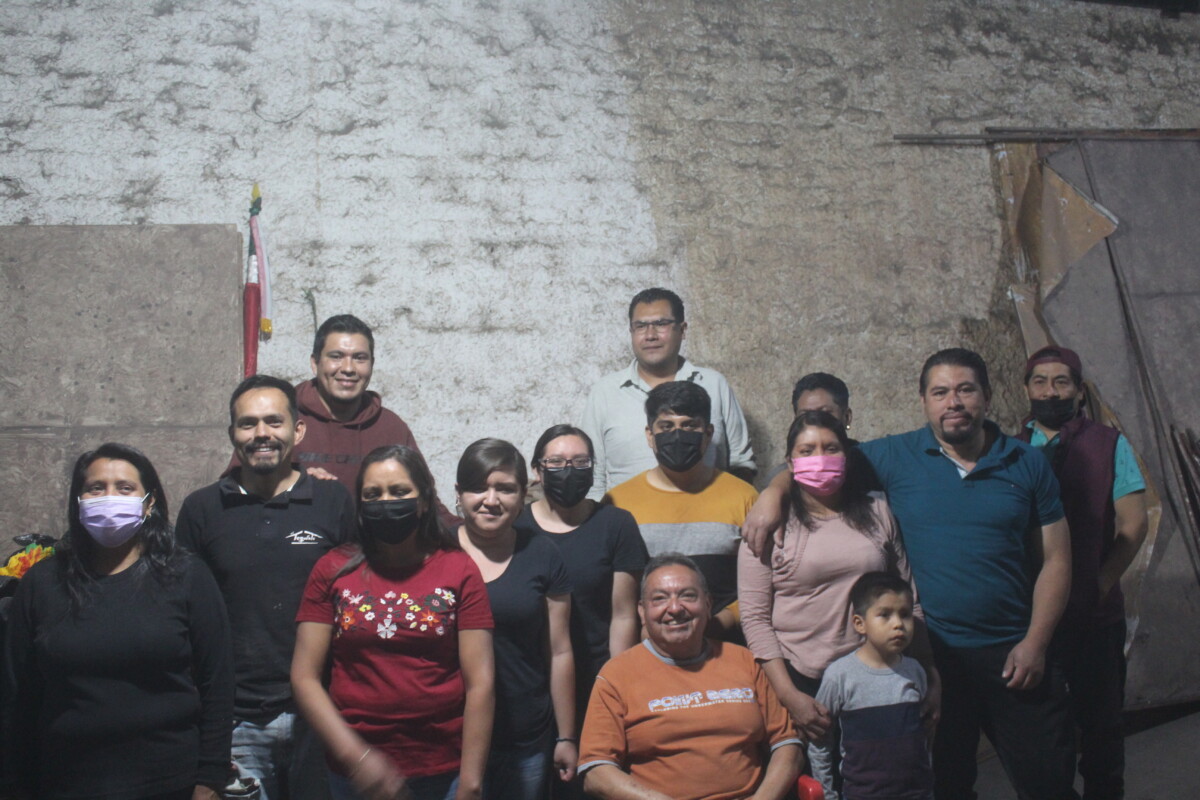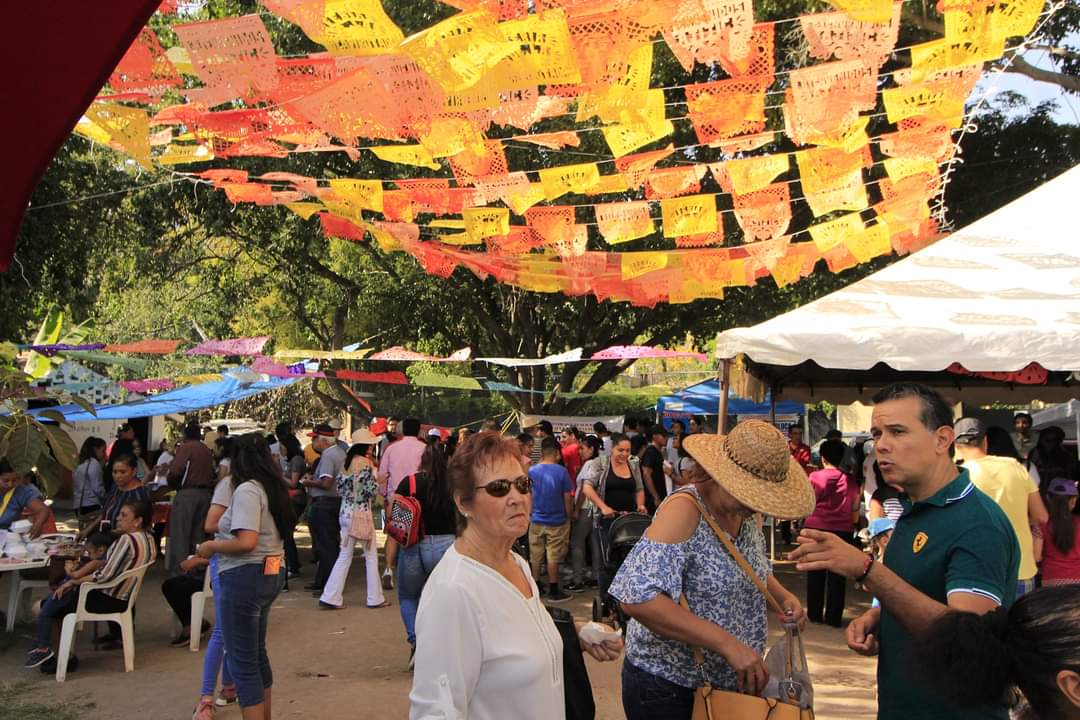tradiciones
Tacos Diana: Preserving a family recipe and sustaining a family
Diana Ramos in front of her stand serving customers during the evening of Tuesday, March 29. Photo: Jazmín Stengel.
Diana Lizeth Ramos Mendoza has not only managed to provide for her three children, but also to keep alive one of the most popular recipes in Chapala.
Diana, who sells tacos in the neighborhood of La Purísima and comes from a family of merchants, married César Abrego, who was the heir to the secret adobo recipe of Tacos Don Max, located on Francisco I. Madero Avenue.
According to Diana when she was married to César, they decided to dedicate themselves to her husband’s family business. Later he went to work with his relatives, but he left her the business when they separated, which Diana took over and has been running ever since.
This is how the young woman, now 29 years old, began to familiarize herself with the process of meats, sauces and marinades. She estimates that she has been running her stand alone for about three years. “After the separation with César «I had to do it all by myself», she said.
Tacos are an important part of Mexican cuisine. Taco Day is commemorated in Mexico on March 31, since 2007. In t México the most famous tacos are: al pastor, carnitas, barbacoa, cochinita, asada, canasta, steamed, golden, placeros, stew, beef and even the governor taco, which is made with wheat flour with shrimp and Oaxaca cheese, very common in the northern coastal part of México. And of course, many other styles.
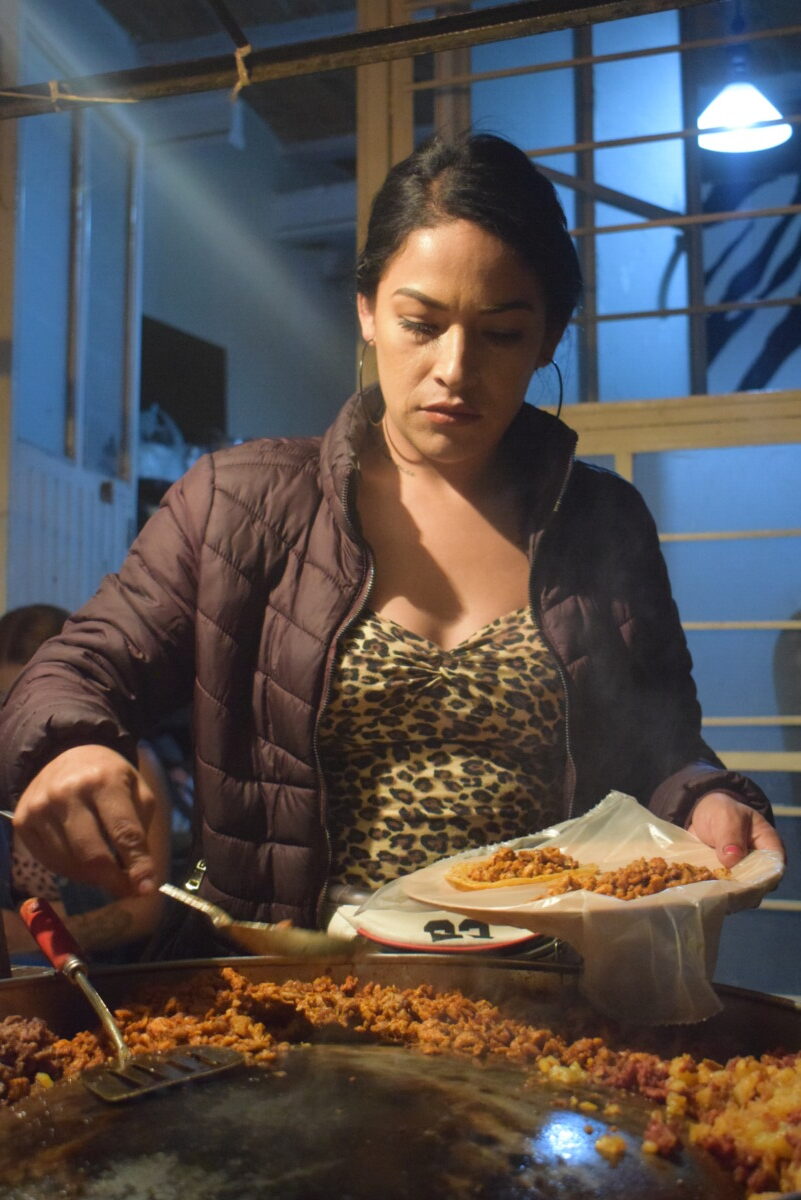
Selling tacos with the adobo recipe inherited from her ex-husband.
Diana’s daily routine consists of getting up in the morning to take her three children to school, then she takes advantage of the trip to order tortillas, buy meat and vegetables at the Chapala market.
After running the errands, she has to pick up the children from school, so Diana barely has enough time to prepare lunch for her two boys and a girl.
Her workday starts around three in the afternoon: chopping onions, cilantro and radishes, preparing the marinade, cooking the meat, vegetables and preparing the sauces. This is something Diana does five out of the seven days of the week with the help of her children.
What convinced Diana to dedicate herself to selling tacos was the ease of taking care of her children while working in front of her house. Today, Diana continues to sell adobada and papa con chorizo tacos from Saturday to Wednesday starting at 8:00 in the evening in the neighborhood of La Purisima, on Miguel Martinez Street, in front of the house marked with the number 477.
However, the low season and the increase of prices in basic foods have forced her to look for other sources of employment to help her to continue with the family tradition of selling tacos.
Translated by Sydney Metrick
San Antonio Tlayacapan’s first fishing tournament tracts 60 anglers and an enthusiastic audience
In the center, the three winners of the tournament. From left to right: Juan Márquez, first place, José Luis Reyes, second place and Wesley García, third place. Photo: Sofía Medeles.
Sofía Medeles (Ajjic).- Sixty fishermen competed in the first fishing tournament in San Antonio Tlayacapan in front of dozens of spectators on March 20.
The event began around eight o’clock in the morning, as the competitors lined the shores of the boardwalk, casting their lines until two o’clock in the afternoon when the awards ceremony was held. The tournament was multi-species; all fish caught were counted in the sum of the total length of all fish landed.
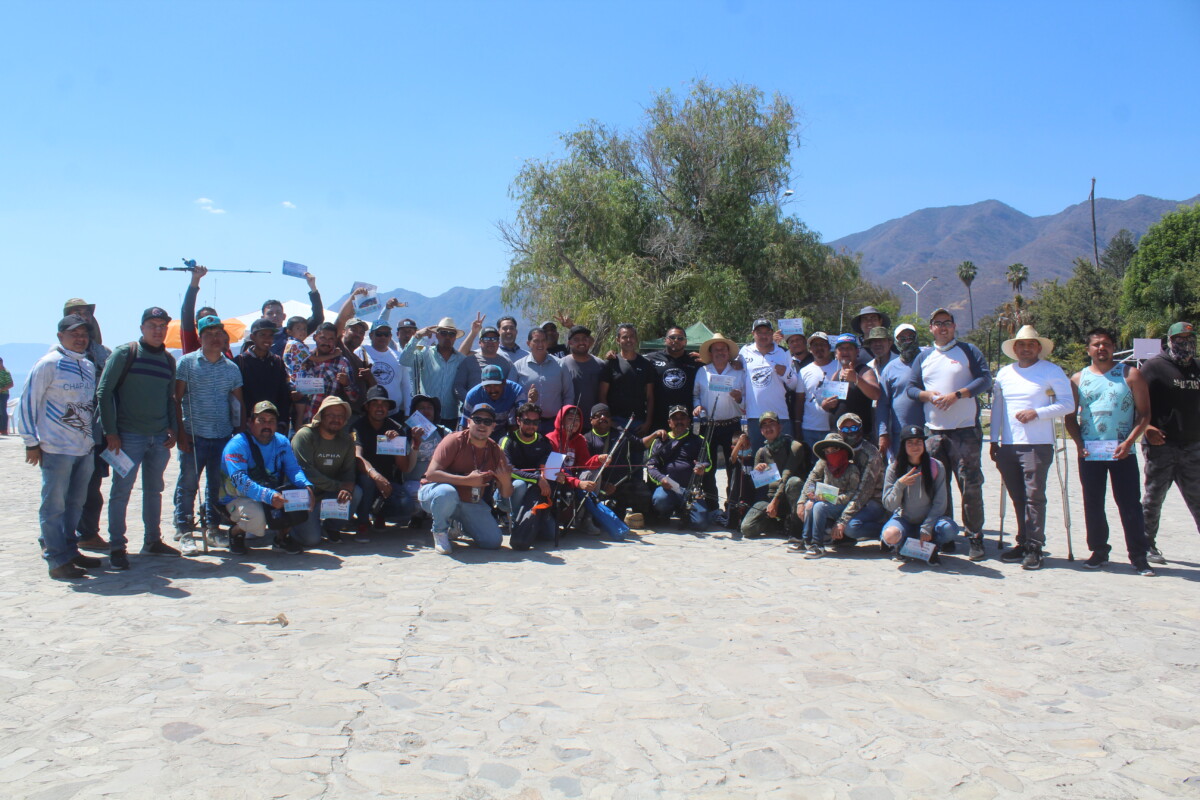
Participants and organizers of the first fishing tournament in San Antonio Tlayacapan. Photo: Sofía Medeles.
First place went to Juan Márquez, who was the only one who met the quota of five fish and received 2,400 pesos. José Luis Reyes came in second place with a prize of 1,800 pesos; while third place went to Wesley García, who also won the category of the shortest fish, or «la cortona», and received fishing equipment and a fishing rod. Román Becerra won the ward for the the longest fish, or «largona».
The tournament was organized by the delegation of San Antonio, and the Municipal Sports Council (COMUDE), in coordination with Pescafina GDL (establishment selling fishing tackle) and Chapalico Bass.
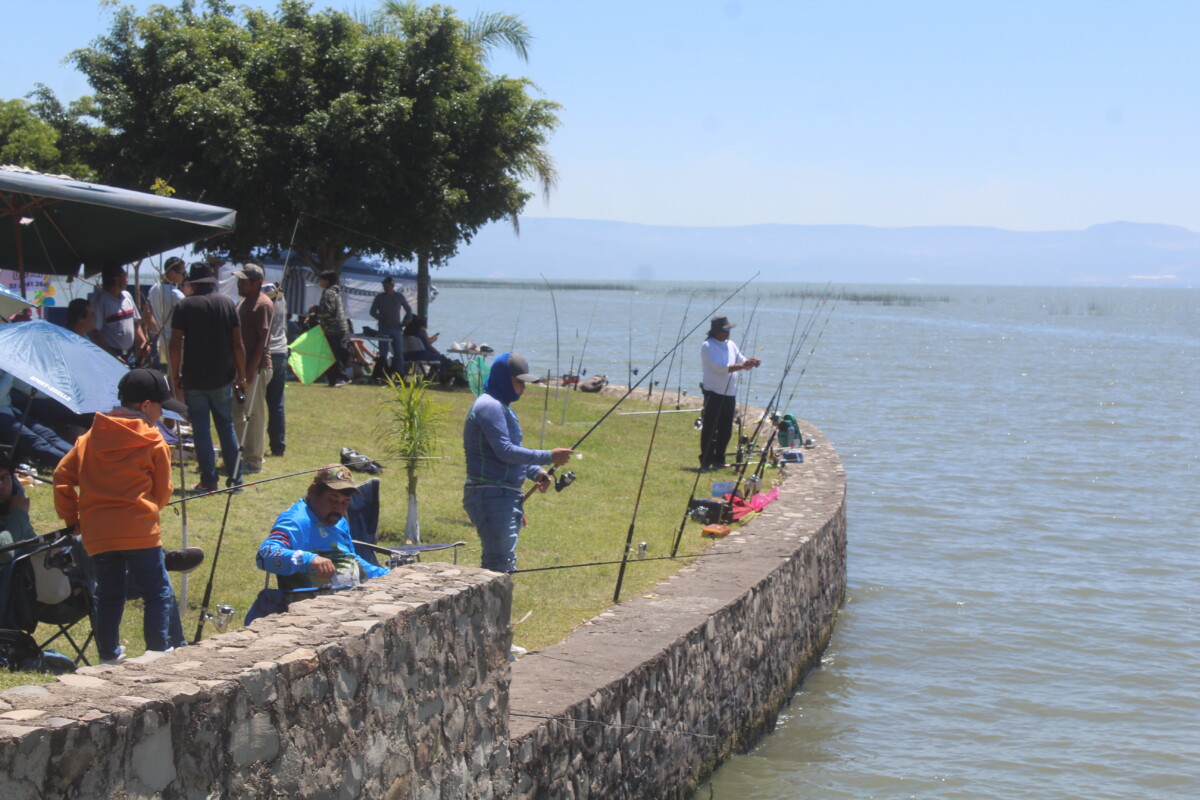
Participants lined the shore of the malecon from eight in the morning until two in the afternoon. Photo: Sofía Medeles.
«It was a quiet tournament, the fishing was a little slow, but it was a pleasant and entertaining experience for the participants, and the people supporting them,» added Miguel, a participant from San Juan Tecomatlán.
Oscar Paredes, from Pescafina GDL, said that this is the first tournament of many that will be held in the town. He also added that, in the next tournaments, he will improve the approach and planning in the lake, so that the fishing takes place without incidents and obstacles such as trammel nets will be removed.
Finally, he thanked the municipal police, civil protection, and authorities who helped organize the event, for maintaining order and safety for participants and attendees.
Translated by Patrick O’Heffernan
Passion of the Christ play seeking actors to play soldiers
Grupo Pasión de Cristo performing work for the verbena and the play’s performance. Photo: Sofía Medeles.
Sofia Medeles (Ajijic).- Organizers of the group Pasión de Cristo say they are relatively on schedule with preparations for the Verbena Jamaica del Pasado and the play, but they need young people to play the role of soldiers.
Although dress rehearsals have not yet begun, they are calling on men to be in the performance. To participate, just sign up at Carretera Oriente #27, Monday through Friday, starting at 7:30pm.
Translated by Mike Rogers
Chronicles of La Ribera
Don Pedro Mendoza Navarro received the «Roberto Montenegro» recognition, granted by the Ministry of Culture of Jalisco for his trajectory as a wool sarapes weaver. Photo: María Reynozo.
Don Pedro Mendoza Navarro, who has been weaving wool sarapes in the municipality of Jocotepec since he was eight years old, is one of the twelve artisans of Jalisco summoned to receive the «Roberto Montenegro» award for his lifetime career as a creator of wool woven sarapes. The recognition is granted by the Ministry of Culture of the State Government to the most experienced men and women.
The Patio de los Angeles cultural center in the Analco neighborhood of Guadalajara is the setting for the award ceremony; since before four o’clock in the afternoon on Friday, March 18, a dozen artisans and their families from some ten municipalities in the state have been seated waiting for the ceremony to begin.
There is a predominance of gray-haired men in the front row; an elderly man in a wheelchair is constantly attended to by his relatives. They adjust his hat, talk in his ear, check his mouth and eyes. One wears light leather huaraches. Two men wear white hats; one of them holds it in his hands waiting for the session to begin. Meanwhile, he spins it around, like the character in Edmundo Valadez’s story (Death has permission) who waits nervously in a meeting.
Doña Elena Quezada Cabrales, 89 years old, embroiderer, is the only woman being honored. She also waits seated next to the man in the wheelchair, in silence.
It is about five o’clock in the afternoon and the artisans are still waiting for the authorities who are about to arrive.
Don Pedro Mendoza, 76 years old, is very happy and nervous too, the wait lengthens the nervousness because he is the one selected to speak once the awards ceremony begins.
-Tomorrow is Saint Joseph the Worker’s Day,» he says, proud to feel the same way, a simple worker who makes pieces worthy of being shown to the world.
One of his sarapes is on display; it is cream colored natural wool with colored threads; the bright rhomboids in the center seem to move, the light blue and red flowers appear bright, next to a poster with a phrase of Don Pedro obtained from a series of interviews conducted by the agency.

The sarapes that Don Pedro weaves on his pedal loom are distinguished by their colorfulness and traditional technique. Photo: María Reynozo.
«When I teach a boy to use the loom, I am happy, because I know that my knowledge will not die when I am gone,» reads the small sign.
According to Rafael Castro Rivera, Head of Popular and Urban Cultures of the state cultural agency, the artisans honored are on average 78 and 92 years old.
Around five o’clock in the afternoon, Margarita Alfaro Aranguren, Director of Artisan Promotion; Lourdes González Pérez, Secretary of Culture of Jalisco and Mario Alberto Limon Carranza, Director of Integral Project Management of the same agency, were present. They occupied the chairs placed at the front of the presidium. Don Pedro and Doña Elena were also there.
In his speech, the Jocotepec weaver expressed his emotion for the possibility of transmitting his knowledge to the new generations through the Jocotepec Weaving School, where he teaches young people to weave wool.
Amidst applause and after the speeches of the officials, the artisans receive the recognition framed in a wooden frame that they embrace for the photo.
The 12 artisans recognized were Alejandro Alfaro, Juan Manuel Águila, Pedro Mendoza, Elena Quezada, Flavio García, Luis Zermeño, Carmen Torres, Jesús Flores, Luciano Jacobo, Jorge Soriano, José Hernández and José Ascensión Juárez.
Around the meeting and on the occasion of the Day of the Artisan (March 19), the head of the Secretariat of Culture organizes the exhibition of handicrafts Made with the heart in which pieces from different municipalities are exhibited. On display are huaraches and cutlery from Sayula, ocochal objects from Mazamitla, pink quarry sculptures from San Miguel el Alto and bone carving objects from Teocaltiche.
The attendees begin to leave, some hurriedly drink the horchata water offered to them and eat the steamed tacos that were served. Others take them and leave in a hurry.
The authorities continue to participate in the tour. Among all the pieces; Don Pedro’s serape seems to shine; the flowers acquire movement when the Secretary of Culture, Lourdes Gonzalez, takes it in her hands in her final tour of the exhibition. Don Pedro talks proudly about his process, showing the authorities his hands marked by a lifetime’s work at the loom. He not only has dozens and dozens of sarapes to his credit, but dozens more on the waiting list. He is finishing a path for the Lord of Huaje, of which he will only charge for the material, because he reiterates, the work for him is not charged.
This weaver of colorful threads represents today the municipality of Jocotepec in an event of austere recognition where what shines the most is that serape dotted with figures that «seem to move».
Translated by Patrick O’Heffernan
Este año, la Verbena Jamaica del Pasado apoyará a enfermos
Verbena Jamaica del Pasado del año 2019. Foto: Luilli Barón.
Sofía Medeles.- La verbena Jamaica del pasado se realizará después de dos años de ausencia: sin embargo, tendrá modificaciones, de las cuales, la principal será que se enfocará en apoyar a las familias de enfermos de Ajijic, permitiéndoles colocar vendimias, convirtiendo el evento en una kermesse. La verbena será el próximo domingo 10 de abril.
El director general de la obra de la Pasión de Cristo, Eduardo “Lalo” Ramos Cordero y el tesorero, Ricardo Mora, comentaron que son 17 familias las que se encontrarán vendiendo distintos tipos de alimentos a lo largo del día, iniciando aproximadamente entre ocho de la mañana y extendiéndose hasta las diez de la noche. En el evento habrá cajas de donaciones, cuyas aportaciones se repartirán en partes iguales a los enfermos.
Además, los organizadores aseguraron que otra de las semejanzas que tendrá el evento con el de años anteriores, será el apagado de luces, la llamada Luz del Pasado que durará media hora y será a partir de las nueve de la noche.
Por otro lado, habrá toldos y mobiliario, los cuales serán aportados por el gobierno municipal de Chapala. La decoración en los puestos será la misma de siempre: con papel picado y carrizos, mientras alrededor de la plaza, se decorará con lámparas de papel y lazos con papel picado.
Bandas locales como La Incomparable, Estrellas del Lago, la Misma Banda y, probablemente, la Orquesta Típica de Chapala, se encargarán de aportar de manera gratuita horas entretenimiento a lo largo del evento, además, autoridades municipales, están buscando gestionar más agrupaciones o ballets que puedan brindar entretenimiento por la mañana.
Aunque los organizadores confirmaron que este año, el grupo Pasión de Cristo no pedirá apoyo, ni en especie, ni monetario, los familiares de los enfermos que participarán en la kermesse, si lo harán entre los vecinos de Ajijic, como solía hacerse anteriormente.
Para finalizar, Lalo Ramos expresó el agradecimiento que tiene él y todo el equipo hacia los habitantes de la delegación, ya que siempre han mostrado unidad y apoyo en estas cuestiones, así como a las autoridades municipales, como el síndico municipal, Gamaliel Soto Pérez y su hermano Carlos, el encargado de despacho Maximiano Macías Arceo y la regidora Denisse Michelle Ibarra, por cooperar con la causa.
Lakeside chronicles
Singer-songwriter Juan José Ramírez Campos is the creator of the song «Jocotepec, la tierra de Dios.» Photo: María Reynozo.
By: María del Refugio Reynozo Medina
Juan José Ramírez Campos, a native of Jocotepec, is a chess player, teacher, and lawyer, but above all, a singer-songwriter.
His mother tells him that, as a child, when they were on their way to school, Juan José used to sing. “Why don’t you shut up,” he was told one day. – “I can’t,» he answered.
In high school, Juan liked to play the flute. He composed his first song while studying for a bachelor’s degree in Education at the Escuela Normal Superior.
In high school he also entered the world of chess. He would go over and watch a group of students who played chess. He spent about two months watching them; one day one of them was absent and they asked him if he wanted to play. He remembers that he played against the weakest player and lost.
“I’m really bad,» he thought. He took it as a challenge, and with the help of a friend he learned. Since then he has not let go of chess; he has participated in municipal, state and world tournaments. He teaches chess at Tecnológico de Chapala and Colegio Jocotepec. He has two diplomas in chess didactics certified by the Ministry of Public Education, and has won international awards.
As a teacher, he has taught philosophy, sociology, economics and history at the Technical University of Guadalajara (UTEG).
Juan José also studied law with an interest in the area of public service. He was secretary general of the Jocotepec City Council from 2015 to 2018. He served as trustee and interim president of this body from 2018-2021.
However, of all his interests, the one that is essential for him is singing and playing the guitar. –“I don’t just play the guitar, I caress it,» he says.
He has 160 songs registered with the National Copyright Institute (INDAUTOR) over a twenty-year career. «Jocotepec, la Tierra de Dios» is his most recent work, written in 2020. For “Juanjo,” nickname for Juan José, the municipality is made up of a diversity of colors. In this piece, the images of the towns that make up the municipality emerge. Each delegation of the municipality has something beautiful to show, he says. The sarapes of Jocotepec and articles made in San Cristóbal Zapotitlán with corn are only a few of the diverse crafts of the lakeside municipality.
The first group to perform Juan José’s material was Banda Esmeralda («Por Ti Mujer»). «El Santo Cristo de la Expiración» has been recorded by Dina Buendia. An agreement is pending with a production company in San Luis Potosí to record «Que Nos Espera» and «La Flor del Edén.» In 2019 he recorded his album «Desde el Corazón de Mi Tierra» with eleven songs, nine of which he wrote himself.
The genres he sings most are huapangos, ballads and rancheras. His compositions are inspired by personal experiences or the issues he observes in society. The song «La Pobreza» came from watching a fire-eater and seeing a homeless man looking for food in the garbage.
Sometimes he is also commissioned to write compositions, like one that a friend asked him to write, «Make me a ballad.» The ballad came out between sips of beer.
His biggest dream is for his songs to be heard by more people.
A notebook and a pen are all he needs when inspiration strikes.
His grandparents taught him a taste for the voices of Agustín Lara, Armando Manzanero and Martín Urieta, and from them he also inherited the love for his land.
«Jocotepec is the land of my love,» he concludes.
Translated by Elisabeth Shields
Peregrinan cosalenses para visitar a la Virgen de Talpa
Personas de todas las edades realizaron el trayecto caminando desde Ameca hasta Talpa con la misión de visitar a Nuestra Señora del Rosario. Foto: Cortesía.
Alma Serrano.- Travesías de la fe. Un grupo de 40 personas originarias de San Juan Cosalá, realizaron la tradicional caminata a Talpa de Allende para visitar a Nuestra Señora del Rosario.
Los fieles salieron el pasado 7 de marzo de la delegación rumbo al municipio de Ameca, donde comenzó su peregrinación que se extendió por cinco días.

Foto: Cortesía.
“Caminamos por las noches y descansamos mientras está el sol, ya que se siente muy caliente. Es indispensable llevar buenos tenis, un buen sombrero, una buena lámpara, se ocupan en todo el camino”, explicó Chela Verar, quien realiza la caminata año tras año, desde hace 27 años.
Personas de todas las edades y sexos, desde lactantes hasta adultos mayores, realizaron la travesía como un acto de fe hacía Nuestra Señora del Rosario de Talpa de Allende; el grupo de peregrinos llegó la basílica la tarde del 11 de marzo.
Chela Verar compartió que esta costumbre está muy presente en su familia que, pese a su dificultad por las largas jornadas de caminata, vale la pena. “Es difícil, pero es una bonita experiencia”, concluyó.
Cada año cientos de cosalenses emprenden este recorrido, ya sea a pie, en bicicleta o en autobús, como manda hacia la Virgen de Talpa por los favores concedidos.
Confirman la realización de la Pasión de Cristo en Ajijic
El grupo Pasión de Cristo se reúnen de lunes a viernes a partir de las 7:30 de la tarde, en el domicilio Carretera Oriente #27. Foto: Sofía Medeles.
Sofía Medeles.- Este próximo abril regresará parcialmente la representación de la Pasión de Cristo, en Ajijic.
El director general de la obra, Eduardo “Lalo” Ramos Cordero, compartió fechas, modificaciones y maneras de apoyar, para las personas que quieran sumarse.
Tras dos años con representaciones simbólicas, Lalo comentó que este año, se realizará una parte de la representación con escenas como “La oración en el huerto”, el jueves 14 de abril a las nueve de la noche; mientras que el Viernes Santo, 15 de abril a las 11:00 de la mañana, será la representación de la Pasión de Cristo en la parroquia de San Andrés Apóstol.
La obra teatral culminará con la crucifixión en el lugar y con el recorrido habitual: La Loma del Tempisque, saliendo de la parroquia, subiendo por Hidalgo al cruce con Juárez, para continuar por Ángel Flores y finalmente tomar Tempisque.
Las partes que se omitirán serán: “La Última Cena”, “El Sanedrín”, el poema final de la Virgen María y los actos que se realizan durante las misas, como lo son el Domingo de Ramos, el lavatorio de pies y la Resurrección. Estas escenas están en duda, porque se está esperando el comunicado de la Arquidiócesis de Guadalajara para que las autorice.
Por otro lado, la verbena “Jamaica del Pasado”, también tendrá modificaciones. No llevará el nombre del evento, ya que, en palabras de Ramos Cordero, este año se realizará una kermesse para apoyar enfermos en el pueblo. Además, agregó la posibilidad de que inicie desde la mañana. El apagado de luces y el papaqui, sí se realizarán con normalidad.
El encargado de los escenarios, Alejandro Márquez, comentó que debido al poco tiempo que tienen para tener lista la escenografía, será sencilla en comparación de otros años.
Asimismo, el tesorero, Ricardo Mora, añadió que el monto aproximado que se necesita para la representación es de entre 150 a 170 mil pesos, los cuales se obtienen de distintos eventos, cooperación de la gente y una parte que pone el Ayuntamiento de Chapala.
Para apoyar con la preparación de la Pasión de Cristo, el grupo organizador se encontrará trabajando de lunes a viernes a partir de las 7:30 de la tarde, en carretera Oriente #27, a un costado de Helados Bok, ubicado en el centro de Ajijic, donde Eduardo dijo que todos son bienvenidos.
Para apoyar económicamente, por ejemplo, con la compra de 24 cascos para los soldados romanos, se puede depositar a la cuenta de banco de BBVA 012346015017717654, a nombre de Eduardo Ramos Cordero.
“Pasión de Cristo, es una obra para evangelizar por medio del teatro, y se ha logrado gracias al apoyo de pobladores nativos y extranjeros, a los cuales se les agradece profundamente por todos estos años de ayuda”, concluyó Lalo.
Por tercer año consecutivo suspenden la Feria de la Capirotada
La última edición de la Feria de la Capirotada se realizó en el año 2019 en el malecón de Ajijic. Foto: La tradición de Ajijic.
Sofía Medeles.- La sexta edición de la Feria de la Capirotada de Ajijic se aplaza un año más para evitar contagios de Covid-19.
El organizador del festival gastronómico dedicado a uno de los platillos tradicionales de la Cuaresma, Lee A. Hopper, expresó no sentirse conforme con la situación de la pandemia ya que no le gustaría que realizar la competencia contribuyera a aumentar el número de casos.
Aunque la Feria de la Capirotada había sido anunciada para el próximo 2 de abril mediante su página de Facebook, a través de un comunicado en la misma plataforma, se notificó la suspensión.
Esta muestra gastronómica se ha realizado desde el 2015, no obstante, fue en el 2019 la última edición. La sexta edición estaba programada para marzo 28 del 2020, pero pocas semanas antes, se habría declarado el inicio de la pandemia en México.
En contraste, la Secretaría de Salud del Gobierno de México en su última actualización del mapa del semáforo epidemiológico, colocó a Jalisco en verde desde el 7 de marzo y hasta el 20 de este mes.
Fat Tuesday Carnival parade returns to Ajijic with bright colors and a lot of flour
Hundreds of Ajijic residents and visitors celebrated Shrove Tuesday 2022. Photo: Arturo Ortega.
Armando Esquivel (Ajijic).- Hundreds of people attended the Ajijic Shrove Tuesday or “Fat Tuesday” parade and many ended up bathed in flour, including the municipal president of Chapala, Alejandro Aguirre, who accompanied the parade in a Can-Am van.
The Ajijic Delegation float led the parade decorated with Chinese paper, fabrics and colorful balloons, with clowns onboard throwing candy and confetti. Following were three golf carts with members of the Expat community on board, who threw candy to the attendees. However, the Expats did not finish the parade because their electric cart batteries died.

Traditional masked Sayaca dances were performed from start to finish. Photo: Arturo Ortega.
The San Sebastian neighborhood, together with the Martinez family, participated with a cart filled with costumed people throwing flour and candy. Young girls dressed in carnival costumes followed in another cart. The rhythm of two drum brigades and a band added flavor to the atmosphere. The fitness community presented a float with gymnastic Sayacas, traditional masked characters usually dressed as women. Another float had playboy «bunnies» throwing flour into the crowd.
One of the most anticipated floats was the flour “cushion”, renamed the «covicolchón.” Characters wearing wrestling masks would carry the «victims» to the cushion to be covered with flour. A cart with a papier-mâché bull and its rider, a mill with aides and another cart with revolutionary sayacos, carrying air rifles and a cannon that threw flour, completed the colorful – and flour-drenched – parade, which ended with a score of charro riders mounted on horses.

The president of Chapala, Alejandro Aguirre, was not spared from the flour. Photo: Sofía Medeles.
The mayor’s team set up a speaker at the last minute so his vehicle would have some music. He had popsicles to throw to the public. Many approached the mayor to greet him, make requests or even have their picture taken, although there was one who gave a whistle or two at him.
After an hour and 40 minutes, the contingent arrived at the main square, where a cloud of flour greeted the floats and the sayacos. The large crowd cheered what many consider the best carnival of Lakeside.

Sayacos dancing the «caballito» or little horse. Photo: Sofía Medeles.
There were minor incidents such as the separation and distancing of the contingent, the departure of the golf carts in the middle of the parade due to the low batteries, two vehicles that were not removed from the parade route and the report of a senior citizen who fell in front of the horses at the end of the parade, which was not included in the Chapala authorities’ news report.
After the conclusion of the parade the streets of the Pueblo Mágico looked empty, with walls and cobblestones bleached by the flour and and covered with colorful confetti which echoed the joy and desire of the inhabitants and visitors to relive the tradition.

The bull could not be missing in this edition of the parade. Photo: Arturo Ortega.

Detailed mask of a sayaco from Ajijic. Photo: Arturo Ortega.

Even the pets enjoyed the carnival parade. Photo: Arturo Ortega.

The flour cushion was one of the most awaited by the attendees.
Translated by Nita Rudy
© 2016. Todos los derechos reservados. Semanario de la Ribera de Chapala
